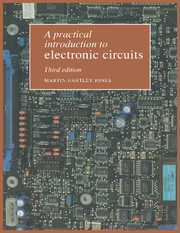Book contents
- Frontmatter
- Contents
- Preface to the third edition
- Preface to the second edition
- Preface to the first edition
- 1 Amplification and the transistor
- 2 The field-effect transistor
- 3 Thermionic valves and the cathode-ray tube
- 4 Negative feedback
- 5 Impedance matching
- 6 Semiconductor device characteristics
- 7 Amplification at high frequencies
- 8 Low-frequency signals, d.c. and the differential amplifier
- 9 Power supplies and power control
- 10 Pulse handling and time constants
- 11 Integrated circuit analogue building bricks
- 12 Positive feedback circuits and signal generators
- 13 Digital logic circuits
- 14 Microcomputer circuits and applications
- Appendix 1 Component identification
- Appendix 2 Transistor selection
- Appendix 3 Op amp data
- Appendix 4 Digital IC connections
- Appendix 5 Interfacing to the PC
- Bibliography
- Index
Preface to the third edition
Published online by Cambridge University Press: 05 June 2012
- Frontmatter
- Contents
- Preface to the third edition
- Preface to the second edition
- Preface to the first edition
- 1 Amplification and the transistor
- 2 The field-effect transistor
- 3 Thermionic valves and the cathode-ray tube
- 4 Negative feedback
- 5 Impedance matching
- 6 Semiconductor device characteristics
- 7 Amplification at high frequencies
- 8 Low-frequency signals, d.c. and the differential amplifier
- 9 Power supplies and power control
- 10 Pulse handling and time constants
- 11 Integrated circuit analogue building bricks
- 12 Positive feedback circuits and signal generators
- 13 Digital logic circuits
- 14 Microcomputer circuits and applications
- Appendix 1 Component identification
- Appendix 2 Transistor selection
- Appendix 3 Op amp data
- Appendix 4 Digital IC connections
- Appendix 5 Interfacing to the PC
- Bibliography
- Index
Summary
The popularity of the first and second editions has been very gratifying. This third edition uses the same practical approach to provide an update relevant to today's exciting electronics scene whilst retaining the character of the basic text.
It is a sign of the relentless advance of electronics that key applications today such as the CD player, cellular telephone and fax machine were nowhere on the scene at the original publication date of 1977. The second edition in 1985 then recognised the burgeoning microcomputer industry, though some home computers popular at that time have now disappeared without trace.
Today, a decade later, the industry has seen remarkable progress, especially in computer processing speed, memory capacity and component packing density. Surface-mount technology is the norm and more and more signal processing and recording is carried out digitally. Fortunately for the student and the experimenter, the basic component and circuit elements explained in the book continue to be just as relevant as ever. Components are still widely manufactured in the wire-ended packages best suited to experimental work; the favourite BC107 transistor remains commonplace. In those circuits where components have become obsolete, suitable updates have been introduced.
In some areas, developing technology has changed the relative importance of particular topics. For example switch-mode power supplies are now deserving of greater coverage, as is the whole theme of analogue to digital conversion. Some other topics no longer as relevant have been quietly dropped.
- Type
- Chapter
- Information
- A Practical Introduction to Electronic Circuits , pp. xviii - xixPublisher: Cambridge University PressPrint publication year: 1995



